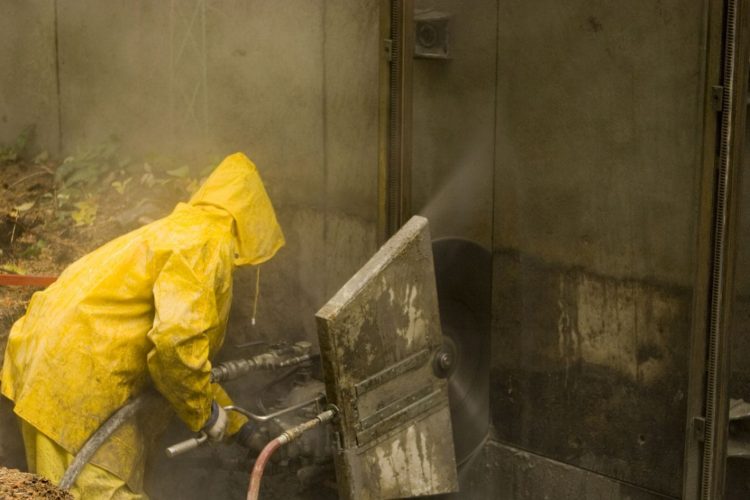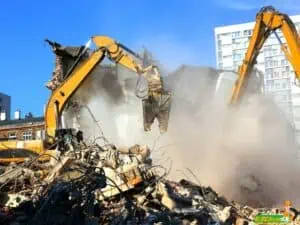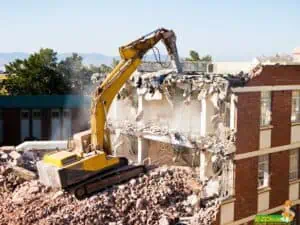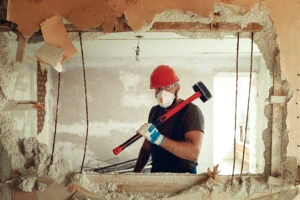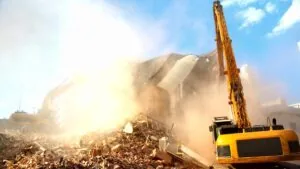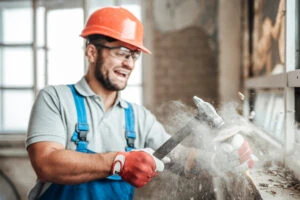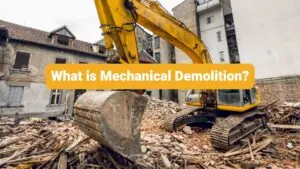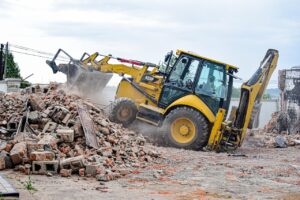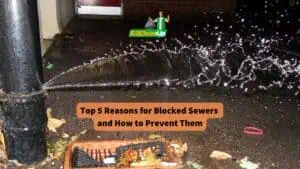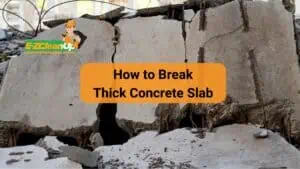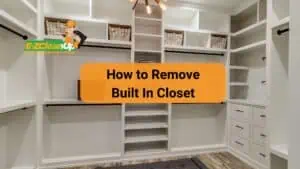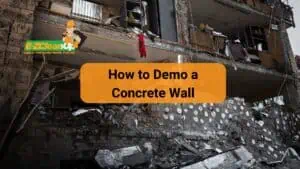A demolition saw, also known as a concrete saw or a cut-off saw, is a powerful tool designed to cut through various tough materials like concrete, bricks, asphalt, and metal.
These saws are often used in construction and demolition projects to break down walls, floors, or other structures.
In this article, we’ll dive deep into the world of demolition saws, exploring their features, types, costs, and limitations.
So, if you’re curious about how these mighty machines work, keep reading to become a demolition saw expert!
What can you cut with a demolition saw?
A demolition saw is an incredibly versatile tool capable of cutting through a wide range of materials. It is particularly well-suited for heavy-duty tasks in construction and demolition projects.
Here are some of the materials that can be cut with a demolition saw:
- Concrete: Demolition saws are perfect for cutting through concrete slabs, walls, and floors. They can easily slice through reinforced concrete, which has steel bars embedded inside for added strength.
- Bricks: Whether you need to create an opening in a brick wall or dismantle an entire structure, demolition saws can make quick work of cutting through bricks and mortar.
- Asphalt: Cutting through asphalt for road repairs or removing layers of old asphalt is another common application for demolition saws.
- Metal: Demolition saws can be equipped with special blades to cut through metal, such as steel beams, rebar, or metal pipes.
- Stone and masonry: These saws can also be used to cut through natural stone, such as granite or marble, and other masonry materials like cinder blocks or limestone.
- Tile and Ceramics: Demolition saws can be used to cut through ceramic tiles, porcelain, and other hard materials, making them useful for remodeling projects or repairs.
- Wood: Although not the primary purpose of a demolition saw, it can be used to cut through wood when necessary, especially when working on demolition projects where wood is combined with other materials.
In summary, a demolition saw can cut through a variety of tough materials, making it an essential tool for construction and demolition projects. Its power and versatility allow it to tackle even the most challenging tasks with ease!
What are the main features of a demolition saw?
The main features of a demolition saw are:
🔧 Powerful Motor: Demolition saws come with strong motors that provide the necessary power to cut through tough materials like concrete, brick, and metal. The motor’s horsepower and torque ensure efficient and precise cuts, even in challenging conditions.
🔧 Blade: The saw’s blade is specifically designed to handle various materials and is typically made of diamond or other abrasive materials. Blades come in different sizes, and the choice of the blade depends on the material being cut and the depth required.
🔧 Adjustable Depth: concrete saws allow users to adjust the cutting depth, enabling them to cut through materials of different thicknesses or to create precise openings.
🔧 Wet/Dry Cutting: Many demo saws can be used for both wet and dry cutting. Wet cutting involves using water to cool the blade and reduce dust, while dry cutting does not require water but may produce more dust.
🔧 Ergonomic Design: Demolition saws are designed with user comfort in mind, featuring comfortable grips, anti-vibration systems, and well-balanced designs that make them easier to handle and control during use.
🔧 Safety Features: These saws often come with safety features like blade guards, lock-off switches, and overload protection to ensure safe operation and protect the user from potential accidents.
🔧 Portability: concrete saws are typically designed to be portable, allowing users to transport them easily to various job sites. Some models come with built-in wheels for easy maneuverability, while others are handheld and lightweight.
These features make demolition saws efficient, versatile, and easy to use, allowing professionals to tackle a wide range of cutting tasks in construction and demolition projects.
What are the different types of demolition saws?
There are several types of demolition saws, each designed for specific applications and varying in power, size, and functionality.
Here, we will compare the main types of demolition saws:
Handheld Demolition Saws:
These compact and portable saws are perfect for smaller jobs and tight spaces. They are lightweight and easy to handle.
Handheld demolition saws are ideal for cutting through concrete, brick, and other materials in tight corners or when precision is required.
However, they may not be the best choice for larger projects or cutting through thicker materials due to their limited power and cutting depth.
Walk-Behind Demolition Saws:
Walk-behind demolition saws are larger and more powerful than handheld saws, making them well-suited for cutting through thicker materials and larger-scale projects.
They are mounted on a frame with wheels, allowing the operator to push the saw along the cutting surface.
Walk-behind saws are ideal for cutting through thick concrete slabs, asphalt, and other heavy-duty materials, but their size and weight make them less suitable for smaller projects or tight spaces.
Wall Saws:
These saws are specifically designed for vertical cutting applications, such as cutting openings in walls or removing large sections of concrete.
Wall saws are mounted on a track system, which allows the saw to move vertically or horizontally along the surface.
They provide precise and accurate cuts, making them perfect for projects that require a high level of precision. However, wall saws are specialized tools and may not be suitable for general demolition tasks.
Wire Saws:
Wire saws use a diamond-impregnated wire to cut through materials. They are ideal for cutting large sections of concrete or stone, as well as irregularly shaped objects. Wire saws offer a high level of precision and can cut through extremely thick materials.
However, they may be more complex to set up and operate, making them less suitable for smaller projects or those that require quick cutting.
In summary, each type of demolition saw has its strengths and limitations. Choosing the right demolition saw depends on the specific requirements of your project.
How much does a demolition saw cost?
Here are a few examples to give you an estimate, but please note that the prices can vary greatly with different types of demolition saws:
| No. | Product Name | Price | Product Link |
| 1. | Stark 3200W Electric 16″ Concrete Cutter Saw (Blade not Included) | $239.95 | Link |
| 2. | XtremepowerUS 2200Watt Heavy Duty Electric Demolition Jack hammer Concrete Breaker W/Case, Gloves | $149.95 | Link |
| 3. | Evolution R255DCT – 10 In Concrete Saw (15A Motor, No Gas – 4-1/16 In Cut – Incl Premium Diamond Blade) | $229.99 | Link |
| 4. | Stark 3200W Electric 16″ Concrete Cutter Saw (Blade not Included) | $239.95 | Link |
| 5. | VICSEC 8” Electric Concrete Saw 4800W Wall Chaser Concrete Cutter (with 8″ Saw Blade, Water Pump, Water Hose) | $168.88 | Link |
Please note that prices may vary over time and may not include shipping, taxes, or other fees. Always verify the current price on the product page before making a purchase.
What are the limitations of a demolition saw?
While demolition saws are versatile and powerful tools, they do have certain limitations. Here are some of the main limitations of a demolition saw:
⏰ Time-consuming: Cutting through tough materials like concrete, brick, and metal can be time-consuming. Demolition saws may not always be the fastest solution, especially if you’re working with large surfaces or thick materials.
🔋 Limited power: Handheld demolition saws, in particular, may not have the power needed for heavy-duty cutting tasks or cut through very thick materials. This limitation can make them less suitable for certain projects.
🔊 Noise: cut-off saws can be quite noisy, creating a disturbance in residential areas or other noise-sensitive environments.
💨 Dust and debris: Cutting with a demolition saw can generate a significant amount of dust and debris, which can be hazardous to the operator’s health and the surrounding environment. Proper dust management techniques, such as wet cutting or using a dust extractor, should be employed to minimize this issue.
🔧 Maintenance: Demo saws, like any power tool, require regular maintenance to keep them in good working condition. This includes cleaning, lubricating, and replacing worn parts, such as blades and filters.
⚖️ Weight and maneuverability: Some concrete saws, particularly walk-behind models, can be heavy and cumbersome to move around, especially in tight spaces or on uneven surfaces.
💡 Skill level: Operating a demolition saw safely and effectively requires skill and experience. Inexperienced users may face challenges with handling and controlling the saw, which can lead to accidents or imprecise cuts.
By being aware of these limitations, you can better determine whether a demolition saw is the right tool for your project and take steps to mitigate any potential issues.
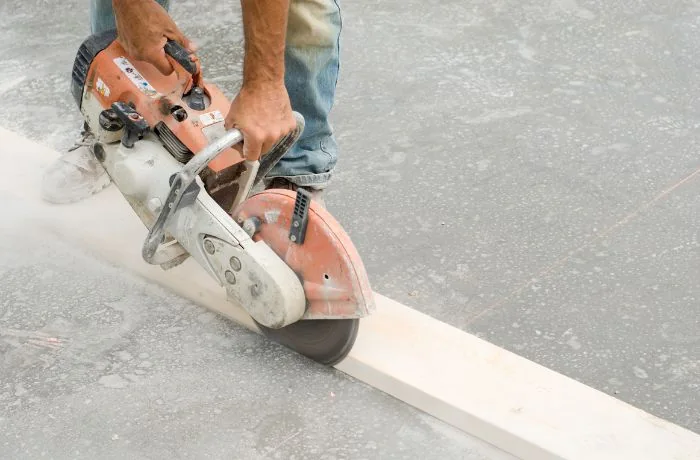
Important safety steps for using a demolition saw
Using a demolition saw requires caution and adherence to safety measures. Here are some important safety steps to follow when operating a demolition saw:
- 🥽 Wear appropriate personal protective equipment (PPE): This includes safety goggles, ear protection, a dust mask or respirator, gloves, and steel-toed boots. Wearing the right PPE can protect you from debris, dust, and noise while operating the saw.
- 📖 Read the user manual: Before using the demolition saw, carefully read the manufacturer’s instructions to understand its operation, safety features, and maintenance requirements.
- 🔌 Inspect the saw before use: Check the saw for any damaged or loose parts, such as the blade, guards, and electrical connections. Make sure the blade is sharp, clean, and securely fastened.
- 🚧 Set up a safe work area: Ensure the area where you will be working is clear of debris and any tripping hazards. Secure the material you are cutting, and mark the cutting line to guide your work.
- 💧 Use water for wet cutting: If your demolition saw is designed for wet cutting, make sure to attach the water supply to the saw to reduce dust and cool the blade during operation.
- ⚡️ Watch for electrical hazards: Avoid cutting near live electrical wires or other electrical hazards. If using an electric saw, use a ground fault circuit interrupter (GFCI) to prevent electrical shock.
- 🚶♂️ Maintain proper footing and body position: Stand to the side of the saw, not directly behind it, to avoid kickback. Maintain a firm grip and use your body weight to control the saw.
- 🛑 Turn off the saw and unplug it when not in use: Always switch off the saw and disconnect the power source before changing blades or performing maintenance.
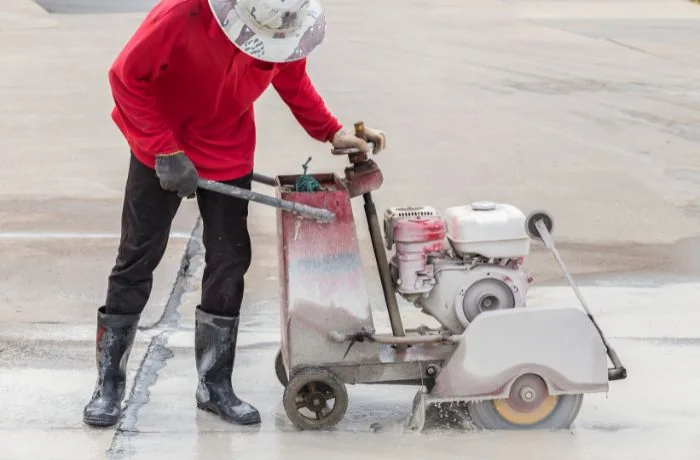
Final words
In conclusion, a demolition saw is a powerful and versatile tool used in construction and demolition projects to cut through tough materials like concrete, brick, metal, and more!
With different types of demolition saws available, each with its unique features and capabilities, it’s crucial to choose the right saw for your specific project.
While demolition saws offer numerous benefits, they also have limitations and require strict adherence to safety measures to ensure safe and effective operation.
By understanding the various aspects of demolition saws, you can make informed decisions and carry out your next interior demolition project with confidence.
Remember always to prioritize safety, maintain your equipment, and follow the manufacturer’s guidelines for a successful demolition experience.

